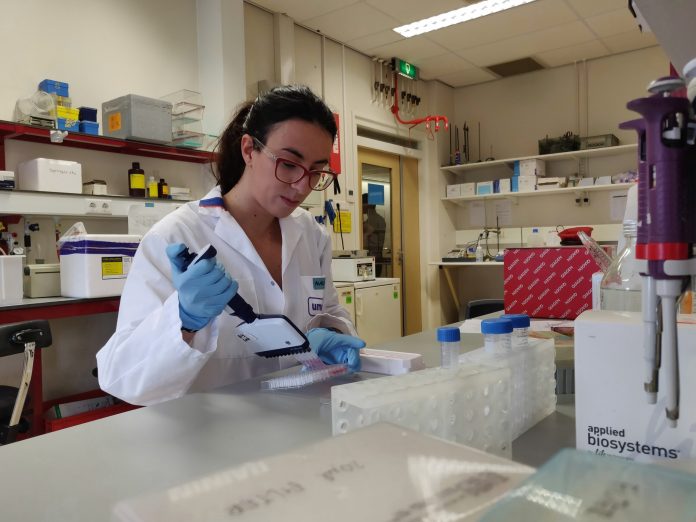LISA BIESOT
Aurora Signorazzi did her PhD on a way to test vaccines with less animal testing. ‘Ultimately, that is what you are looking for in science. That you find something that is not yet known.’
Overall on. Zip up. Face mask and glasses. Put on gloves. Second pair of gloves. Every day, every time you go into the lab. Because that is the usual routine when you are working with a dangerous virus.
For four years, this was Aurora Signorazzi’s daily routine because of her work in the UMCG’s virology lab. There, she worked on an animal-friendly way of testing the quality of the TBE vaccine, on which she recently obtained her doctorate.
Half a million animal tests
Animal tests are still indispensable in scientific research and in the pharmaceutical industry. In the Netherlands just under half a million animal tests were carried out in 2020. Some of these were for fundamental research – the UG carried out 17,000 – but the industry also relies on animal testing for the development and testing of vaccines.
Each batch of vaccines produced is tested for safety and effectiveness before being administered. Often, mice or rabbits are given a shot for this purpose. This is necessary because a vaccine often reacts very differently in the body than it does in a test tube.
But Signorazzi’s idea was that her work would actually reduce the number of animal tests. ‘In these cases, you are looking at a black box’, she explains. ‘You only get a ‘yes’ or ‘no’: the vaccine works, or it doesn’t.’ What exactly happens in the body remains hidden. On top of that, animal testing is expensive.
Tick virus
Enough reason, therefore, to look for alternatives. Signorazzi concentrated on the vaccine against the TBE virus that is sometimes present in ticks and can cause meningitis in humans. ‘I wanted to know whether you could test the vaccine against it in an animal-friendly way in a petri dish.’
To do this, she first had to know more about the vaccine that was being used. ‘The tick virus and the vaccine against it had not yet been properly researched,’ she says. For example, it had never been demonstrated exactly how the immune response that the virus and the vaccine induce in your body is set in motion.
But she did have some clues: a protein called RIG-I can recognise many viruses. When it detects a virus in your body, it signals the immune response to start. It could do the same with the tick-borne virus, but as far as we know, the protein only does that with viruses that replicate, and TBE is a ‘dead’ virus that does not replicate.
Big moment
‘That was a big moment,’ she recalls. ‘It felt like I had solved that issue. Ultimately, that is what you are looking for in science. That you find something that is not yet known, and can fill that gap.’
This paved the way for the next step. She extracted human immune cells from the blood of blood donors. She added a little vaccine to the immune cells to see how the cells reacted. If there was an immune response, it was effective.
‘I also mixed good and bad vaccines’, she says. ‘For example in the ratio 50/50 or 20/80.’ This turned out to correlate exactly with the activation of the immune response, much more precisely than she had ever seen in animal cells. That means her method can eliminate ineffective vaccines even before animal testing begins, and much fewer animals will be needed.
Perhaps these kinds of tests will some day lead to animal testing becoming completely superfluous. ‘The idea is that you have so many different methods to support your decision that you don’t need animals at all.’
Corona vaccine
Signorazzi’s vaccine research also turned out to be the perfect stepping stone for the rest of her career. She could almost immediately start working at Janssen Vaccines, where she checks the safety of vaccines – yes, mainly the corona vaccine. The best part is that she is once again working on developing methods to reduce the use of laboratory animals. ‘Pharmaceutical companies are constantly looking for new and better solutions. They are really trying to find out how they can make something even more effective, or even safer.’
Especially now, the importance of scientific research is apparent. ‘We were able to develop the corona vaccine in a year because all the necessary research had already been done’, she says. ‘We should continue to do that, we should continue to develop. Because this won’t be the last pandemic.’
Negative reactions
Unfortunately, not everyone sees it that way. ‘I get negative reactions from some people. They don’t trust the vaccine. They say that I don’t know anything about it, or that I am paid to say certain things. Times like that aren’t fun when you’ve been studying vaccines for years.’
She finds it incomprehensible. ‘Next to clean drinking water, vaccines are the most important reason that we now have such a long life expectancy.’




